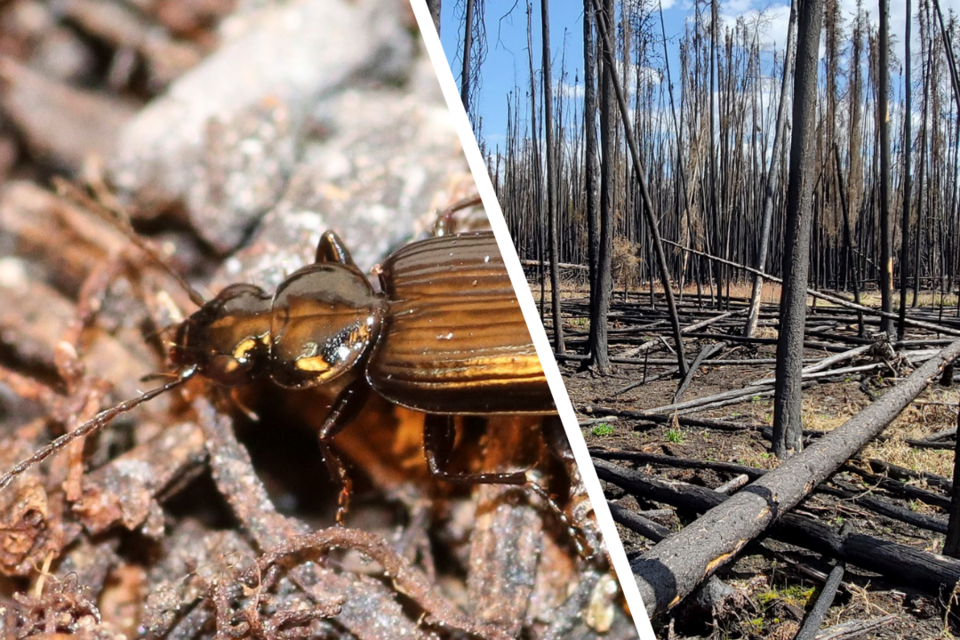SASKATOON – With a rise in the number of wildfires in Saskatchewan and beyond each year, burnt landscapes stripped of plant life are becoming more common. Most creatures find a burnt environment uninhabitable, but a University of Saskatchewan (USask) research team has discovered how certain species of insects use these scorched lands as a safe location to lay eggs.
“Most animals can't handle the heat of an active fire, but once the fire is out it becomes a beacon that attracts all kinds of things,” said Aaron Bell, a biology PhD candidate in USask’s College of Arts and Science and co-author of the study. “Many animals (not just insects but also birds and mammals) are attracted to recent burns and make use of these habitats in the immediate aftermath of fire.”
According to the USask-led study recently published in the journal Ecosphere, researchers found that pyrophilic—or ‘fire loving’—beetles that lay their eggs in burnt habitats tend to have an 80 per cent increase in reproductive output compared to individuals that lay eggs in unburnt forest soil, demonstrating an important environmental use of wildfire-affected habitats.
“Unburnt soils are full of small microorganisms that readily attack and kill vulnerable eggs, whereas soils exposed to the heat of forest fires are temporarily devoid of these predators and pathogens,” said Bell. “Many insects use burnt forest landscapes for reproduction, but pyrophilic insects do it best. Until now, we really didn’t understand what benefit they’re getting from colonizing the burnt environment so quickly.”
Using the recent forest fires in Fort à la Corne in 2020 and near Prince Albert in 2021 as study locations, the research team found that the burnt soil environment is quickly colonized by pyrophilic beetles that take advantage of the heat sterilization of the surrounding soil to lay eggs that have a better chance of survival, thus increasing their reproductive success rates. These findings shed light on the peculiar behaviour of these insects and help explain why they colonize the burnt area so quickly, often while the fire is still burning.
The work also suggests that reproduction in pyrophilic insects is strongly linked to naturally occurring fire. The research team included USask College of Arts and Science adjunct professor Dr. Iain Phillips (PhD), USask alumna Kiara Calladine, and co-supervisor Dr. David Wardle (PhD), a professor at Nanyang Technological University, Singapore.
Currently, only about 60 species of insects around the globe are known to exhibit this type of behaviour, but there are likely many more, Bell said.
“It wouldn’t surprise me to learn that more species show this type of association with fire, especially in ecosystems like the boreal forest where fire has been a strong shaping force for thousands of years,” said Bell. “The ecology of many insects is poorly understood.”
The work can be applied to understand and estimate both the positive and negative impacts of wildfire for people, animals, and the environment.
“Periodic wildfire is important for maintaining healthy forests and habitat for many species that have co-evolved with fire, but fires often encroach on communities, threatening lives and human values,” said Bell.
“The Cloverdale Fire, which threatened the community of Prince Albert and knocked out power to northern Saskatchewan for four days last May, is an illustration of this balancing act – how do humans maintain healthy ecosystems and species that rely on fire while also keeping people and the things we value safe? It’s important to protect humans and the things we value, but the decision to allow a fire to burn or to put it out has consequences that go beyond us.”
The research was supported by the Natural Sciences and Engineering Research Council of Canada, the Queen Elizabeth II Centennial Aboriginal Scholarship, the Entomological Society of Saskatchewan, the Entomological Society of Canada, and the Gabriel Dumont Institute.
— Submitted by USask media relations



